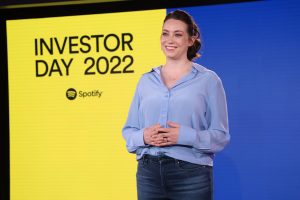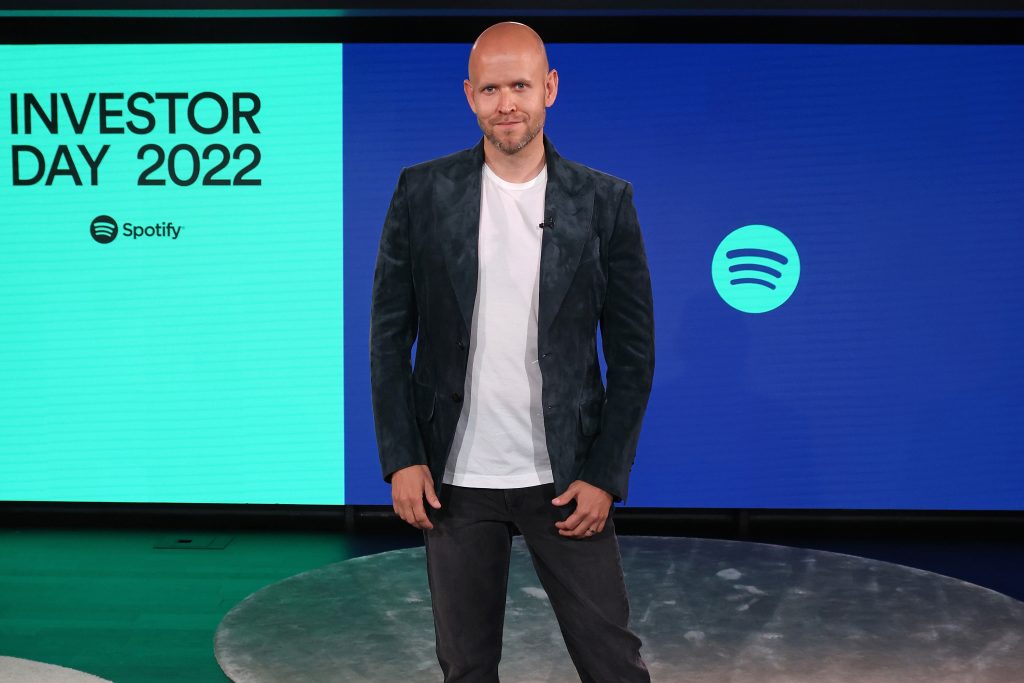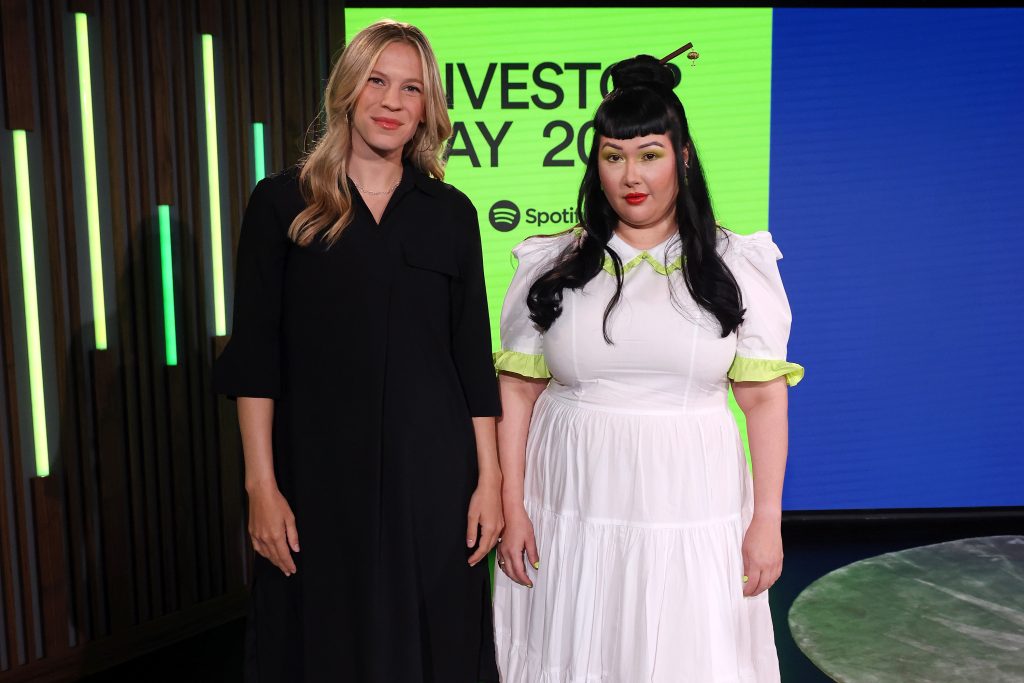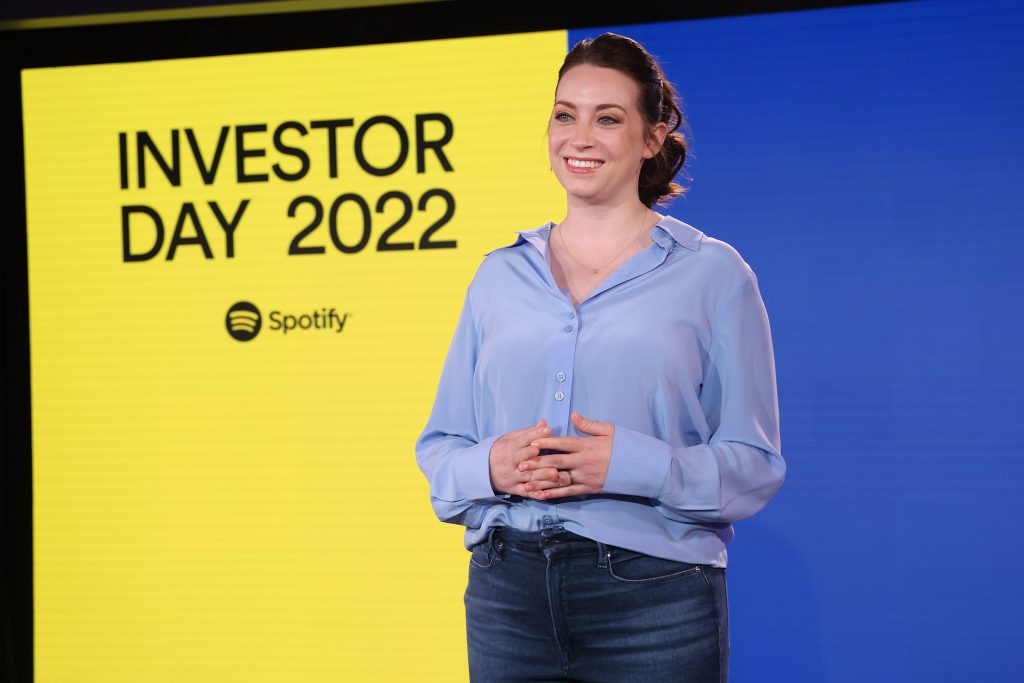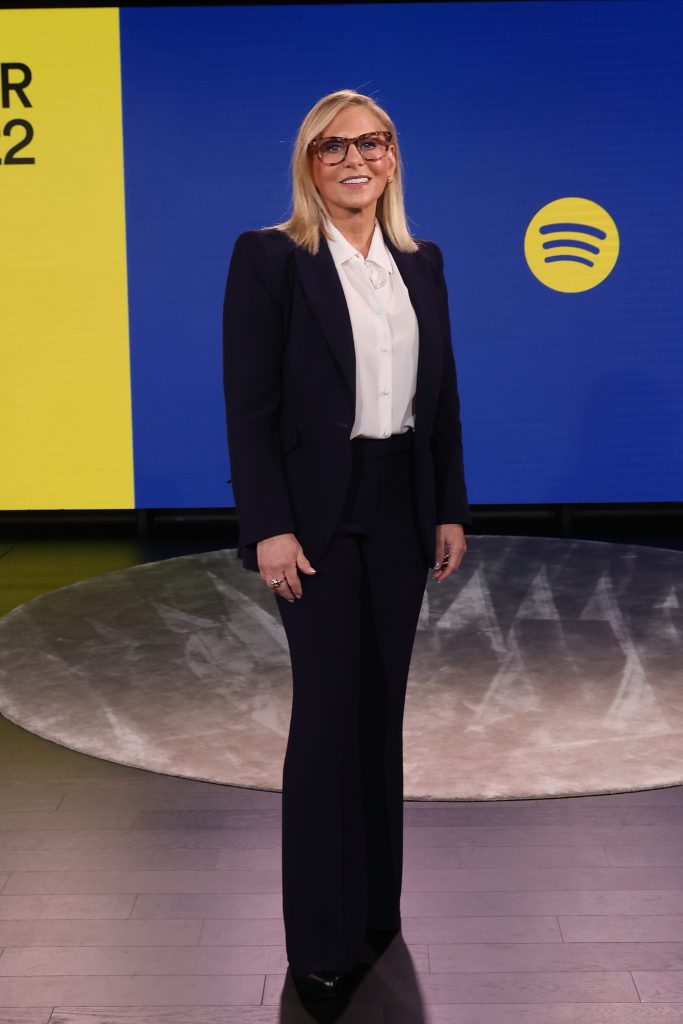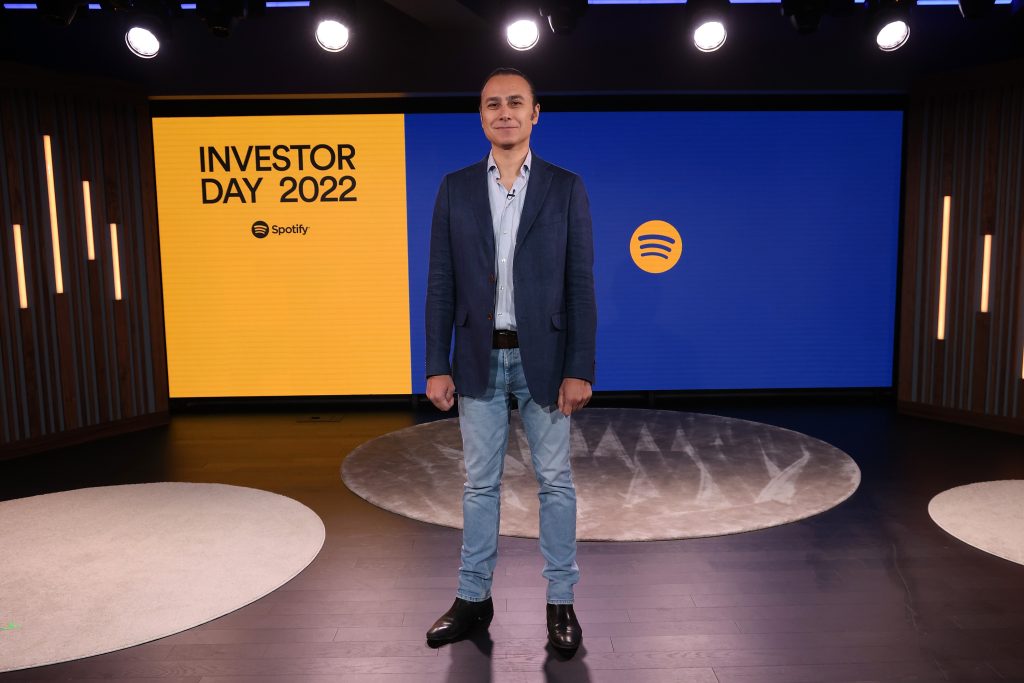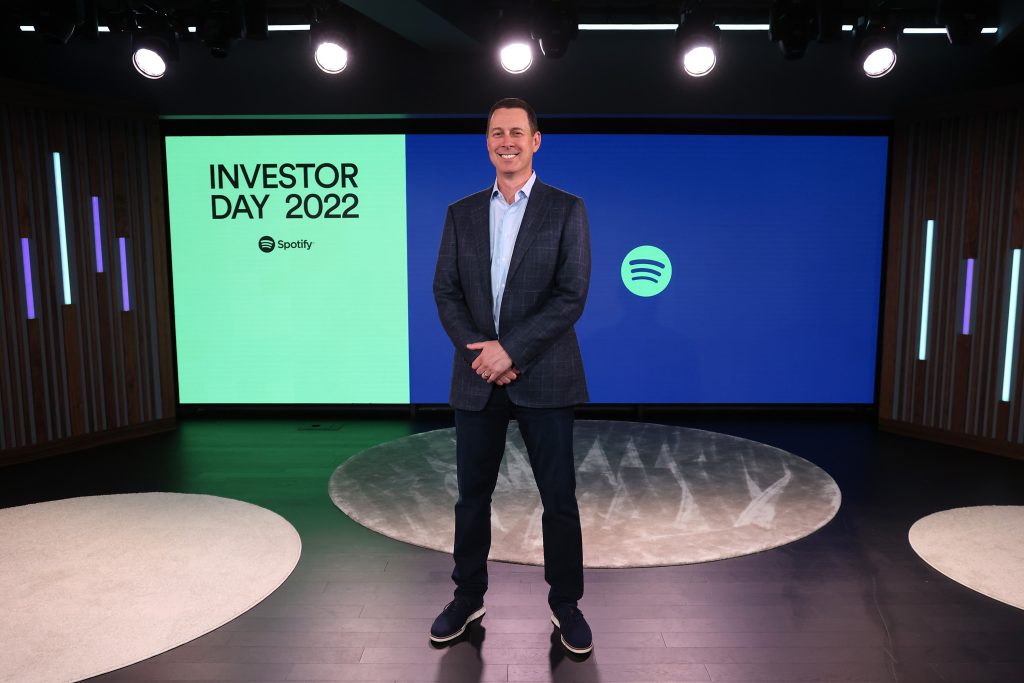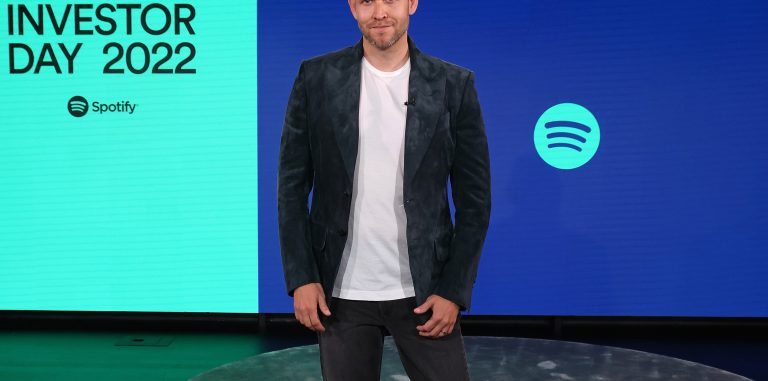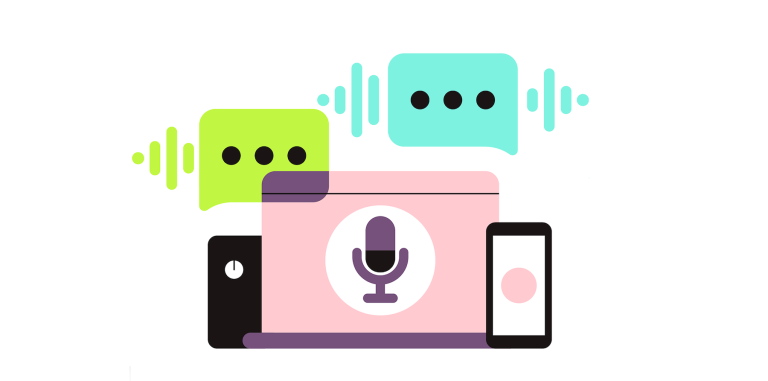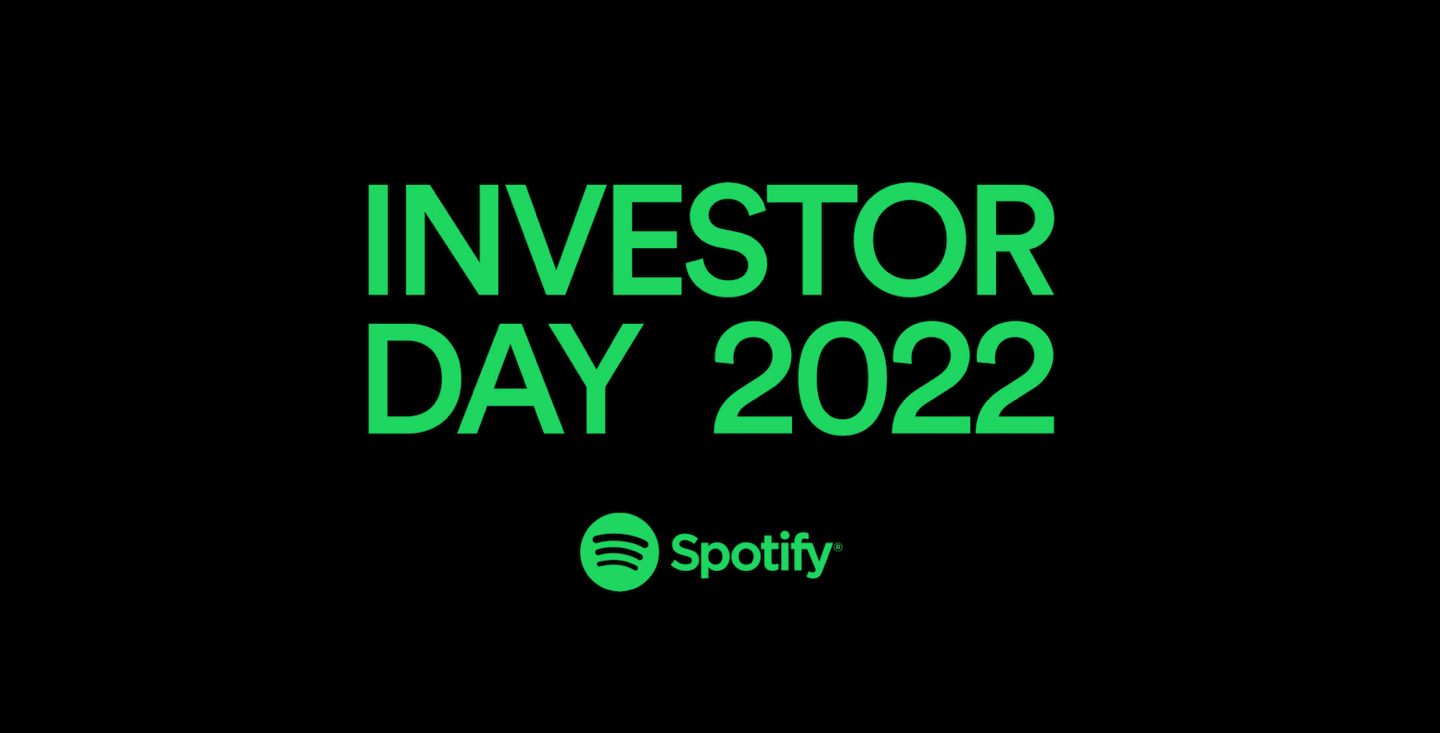
Spotify Shares Our Vision To Become the World’s Creator Platform
Investor Day 2022
Today, Spotify hosted our second Investor Day, updating the financial community on the progress we’ve made since our direct listing. Additionally, we shared details about how we’ll continue to innovate and grow over the short and long term. The event, which was held at our New York City office, featured presentations by Spotify’s Chief Executive Officer Daniel Ek, Chief Financial Officer Paul Vogel, and members of the company’s global leadership team.
When Spotify went public in 2018, we were a music-streaming company, but we’ve evolved dramatically over the last four years—expanding beyond music to become the leading player in audio.
Throughout the event, Spotify executives highlighted the consistency of our financial performance, our strong momentum, and the potential we see ahead for driving meaningful user, revenue, and bottom-line growth. They also built the case for why our future extends beyond music and podcasting, describing a reality where 50 million artists, writers, labels, publishers, studios, and other creators will be able to manage their businesses and monetize and effectively promote their work to more than one billion users.
At the center is a set of software, services, products, and business models tailored for specific verticals and bundled into a single consumer experience: The Spotify Machine.
Read on for top takeaways from our speakers.
Daniel Ek describes the foundations of our strategy and “The Spotify Machine”
“We’re really investing in building a fantastic multisided platform that has all the ingredients to become one of the truly unique creative platforms in the world,” Daniel shared in his opening remarks. “And based on what we see, we are accelerating our moves to seize that opportunity in the near term. And the value creation opportunity is very high.”
He then outlined at a high level what Spotify has achieved since 2018 and revisited the three key foundations that continue to differentiate Spotify and drive our long-term strategy:
Ubiquity: It’s long been our goal to make Spotify available to anyone on any device. Over the last four years, we’ve gone from approximately 250 partners to more than 2,000 today, with integrations ranging from wearables like watches to all facets of the connected life—including cars and kitchen appliances. Ubiquity has proven to be a significant driver of new users to the platform, with 28% of all our new registrations coming from these partners, up from 14% in 2018.
Personalization: When you ask listeners what they love most about Spotify, more than 81% cite our personalization, or discoverability. That magic ability to introduce a user to their next favorite song and artist. Spotify listeners view this as the reason not only to sign up for our service, but also to stay.
Freemium: The combination of our free ad-supported tier and our premium subscription tier. It gives listeners a chance to try Spotify risk-free, enables Spotify to build a funnel toward establishing a larger and growing subscriber base, and has enabled our expansion into new markets due to our low price of entry—we’ve gone from 65 markets around the world to 183 in just four years.
“We see the opportunity to continue to imagine and explore new verticals across our platform—within audio, but also beyond.” Daniel noted. “And for each vertical, we will develop a unique set of software, services, and products and business models that’s going to be tailored for that specific ecosystem.”
Chief R&D Officer Gustav Söderström lays out the benefits of a single user experience
Joining the stage after Daniel, Gustav Söderström, Spotify’s Chief R&D Officer, provided a deeper look into that future from a product point of view.
While there’s much that goes on behind the scenes of the Spotify app, the end result is a single intuitive experience for listeners that brings the world’s audio content together in a relevant and personalized way. And that’s what we’ll continue to do as we add new format verticals, like audiobooks, to the Spotify app.
Gustav also shared how this strategy has been successful over the last few years in compounding our user base. He noted that in 2019 we integrated podcasts into the main app, making them available to over 200M potential listeners. In 2020, we did the same with video podcasts, in 2021 with Live, and in 2022, we’re integrating audiobooks into the main app, making them available to over 400M potential listeners.
Finally, Gustav explained Spotify’s personalization engine, which is shared among all of our content formats. “Investments in this space allow for the personalization engine to get better and better as new formats are added, ultimately giving us a better understanding of every user and how we recommend to them. To a large extent, the value of a service like Spotify is directly related to how much a consumer feels like that service helps them discover new things,” Gustav said. And that’s what Spotify enables. In 2018, we had 10 billion artist discoveries every month on Spotify. Today, there are 22 billion and we’re nowhere near done.
Global Head of Editorial for Music Sulinna Ong, Global Head of Music Content Strategy Madeleine Bennett, and Vice President and Head of Music Product Charlie Hellman share insights on music, our marketplace, and helping artists monetize more fans
“First and foremost, Spotify is a music company,” Charlie Hellman noted upon taking the mic. “All of our music teams’ strategies ladder up to two primary goals: making a unique and superior music experience for fans, and creating a more open and valuable ecosystem for artists.”
“We are by far the most global platform, the most tapped into local scenes, and the most capable of developing opportunities for artists at scale,” Sulinna Ong shared. “No other streaming service is better positioned to identify, amplify, and help shape culture than Spotify.”
“We are the preferred destination for artists, because we help to take an active role in achieving their dreams and partner with them on thinking outside the box, working together to help them succeed,” Madeleine Bennett said. “By unlocking the ability of any artist—from anywhere in the world—to connect with listeners everywhere, we are tapping into a potential market of billions of people everywhere.”
One of the reasons that we’re the go-to destination for artists is because we uniquely provide them with a core set of valuable free resources, useful for any stage of an artist’s career, that help them get their music in front of the right fans. In addition to these free tools, we’ve invested in building the most performant and effective commercial tools for promotion in the streaming era.
In 2020, we introduced our Discovery Mode program, which is powered by algorithmic promotion and is loved by those who have tried it. From Q121 through Q122, Discovery Mode had 98% customer retention. And in early testing, artists with tracks opted in to the program increased their listenership by an average of 40%. Almost half of that growth came from listeners who had never listened to the artist before.
With Marquee—our full-screen, visual, sponsored recommendation of artists’ new releases—we recently expanded access by rolling out a self-serve buying experience in the U.S. As a result, we doubled the number of new customers from Q4021 to Q122 while maintaining an 85% retention rate. And in Q122, revenue grew 224% year over year.
In addition to helping artist teams promote and grow their audiences on an ongoing basis, we’re also focused on helping them earn in more ways. Beyond music, touring and merchandise are significant pieces of the equation. So we’re building solutions for both artists and fans, all while growing new lines of profit for artists and Spotify.
We’ve integrated listings from top ticketing platforms to sell concert tickets at scale within Spotify. We’ve also enabled artists to sell merch, vinyl, and other offerings directly to fans via their Spotify artist pages through a custom integration with Shopify. And we’ve continued to make great progress with our Fans First program, which uses Spotify data to identify and reward the most passionate fans with exclusive offers, like advance access to concert tickets, exclusive merchandise, or invite-only events. To date, the program has generated more than $300 million in revenue for the music industry.
We also want to open up ways for artists to directly interact with their audiences, creating meaningful engagement and monetization opportunities. One new experience is exclusive live audio rooms where artists host their top Spotify fans. Here, artists can celebrate a special musical moment like a new release and earn revenue by selling merch, promoting concert tickets, and receiving tips—all inside the live room.
“As we diversify revenue streams for artists and identify the best ways to increase spending from a user base that is on its way to 1 billion, we will further enrich artists—even outside of their rapidly growing streaming royalties—and deliver margin impact for Spotify,” Charlie concluded.
Head of Talk Verticals Maya Prohovnik tauts Spotify’s creator tools across podcasting, video, and live
In just under four years, Spotify went from having few podcasts on-platform to being a global leader in the market.
Consider the numbers: When Anchor joined Spotify in 2019, there were fewer than 500 thousand podcasts on the platform. Today, there are over 4 million, and Anchor powers more than 75% of them. Those millions of shows being published to Spotify from Anchor are often being made by first-time creators. And as those creators make their content, they share it with their friends and family off-platform. And the result? On average, every new Anchor show brings 2.5 additional monthly active users (MAUs) to Spotify.
“With that critical mass of both creators and consumption in the same ecosystem, we’re able to do something that has not been possible in nearly 20 years: actually innovating on the podcast format itself,” Maya shared.
We’re doing this in a few ways.
First is format innovation.
- Music & Talk makes it possible for creators to include any music track from the Spotify catalog in a show—and for music rights holders to get paid when their tracks are being played as part of the Music & Talk episodes.
- Video podcasts are a result of more and more consumers’ watching their favorite podcasts—not just listening. Now, creators can upload video podcasts directly to Spotify from Anchor—it’s just as easy as publishing an audio podcast.
Next is interactivity.
- Q&A and polls are text-based questions that can be posed by the shows’ creators and surfaced to listeners in the Spotify app—creating a direct, on-platform connection between listeners and creators.
- Spotify Live makes it easy for the top podcasters to livestream audio to their biggest fans so creators can reach their listeners where they already are.
Finally, monetization.
- Advertising features on Anchor are enabling more creators than ever to participate in the podcast advertising space.
- Podcast Subscriptions unlock a meaningful revenue model for many creators. Because of the tight connection between creators and their fans on Spotify, the on-platform average subscriber retention rate has been 90% since launch.
- Spotify Open Access provides customers who are already paying for exclusive content off-platform the ability to connect their existing accounts to Spotify so they can easily find and unlock their content on-platform.
“This has opened up a new world of opportunity to add features and formats to the podcast-listening experience that have never been possible before—so Spotify is now not only differentiated by our catalog of content, but also by delivering a truly superior product for podcast listeners and creators,” she concluded.
Chief Content & Advertising Business Officer Dawn Ostroff projects podcasting’s long-term power
Spotify’s origins are rooted in music, but our future is supporting creators across audio—and we’ve taken the learnings from our success in music to propel our podcast business forward.
Dawn explained that our investments in top-tier exclusive and original content create real value for Spotify in four ways:
- We leverage exclusive programming to attract existing podcast listeners from other platforms and bring them to Spotify, as well as introduce non-podcast listeners to the medium for the first time. Most importantly, we engage the music-only audience already on our platform to turn them into music and podcast listeners.
- Having top-tier podcasts like Call Her Daddy and Armchair Expert serves as powerful leverage with hardware platforms, many of which are our direct competitors.
- The excitement around our Premium content also attracts blue chip advertisers, many of which try podcast advertising for the first time and then keep coming back.
- Hit originals create a cultural halo effect for Spotify, keeping us front and center with audiences and creators. Just take Batman Unburied, Caso 63, and Gemischtes Hack—soon to be followed by the first series from Kim Kardashian; Archetypes from Meghan Markle, The Duchess of Sussex; and the terrifying first series from Jordan Peele’s Monkeypaw Productions.
This strategy is proving to be successful: “Our original and exclusive shows account for 15 of the top 100 podcasts on Spotify—a significant achievement given that we produce or license only 1,000 of the more than 4 million podcasts currently on the platform,” shared Dawn. “And six of the top 10 shows are Spotify exclusives.”
To date, we have committed more than a billion dollars to podcasting in order to grow the podcast audience and transform the industry. And this investment brings with it significant long-term upside: In 2021, we generated close to €200 million in podcast revenue. We expect this to increase materially in 2022, and going forward, we believe podcasting in itself will be a multibillion-euro business for Spotify.
Thinking about the podcasting industry as a whole, before Spotify entered podcasting in 2018, the annual ad spend in the U.S. was approximately $480 million. At that time, it was projected to hit $1.1 billion in 2022. Today, podcasting is expected to exceed $2.1 billion in 2022—almost double the initial projections and over 300% growth since 2018. What’s more, the market is expected to double by 2024 to reach $4.2 billion.
And while the U.S. is a key market for podcast advertising, podcasting adoption is growing internationally, especially in markets such as the U.K., Germany, and Brazil.
The number of people engaging with podcasts is also growing. Since 2018, we’ve gone from less than 7% of listeners on Spotify spending time with podcasts to 30% of users monthly. Users who listen to both podcasts and music listen twice as much as users who only listen to music. And that extends beyond listeners: In the U.S., when we bundle music and podcast advertising, the average size of the spend on a campaign is four times that of a music-only campaign, so we’re driving bigger spend from advertisers and significantly growing our revenue.
Global Head of Audiobooks Nir Zicherman reads the opportunity in the new medium
By introducing streaming technology to podcasting, Spotify helped create audio experiences that were not possible before. Like with music and podcasting, we see an extraordinary opportunity to invest, innovate, and grow audiobooks. The vertical holds massive possibilities to build on our ambition to be the destination for a wide array of creators. The global book market is estimated to be around $140 billion, with audiobooks having only a 6%-7% market share.
At the end of 2021, we announced our plans to acquire Findaway and enter the audiobook space. Findaway works across the entire audiobook ecosystem, with a platform and offerings that serve authors, publishers, and consumers. We plan to build on its expertise and infrastructure to deliver tools and resources that will lower the barriers to entry and enable creators to find an audience—expanding the audiobooks market overall, just as we did with podcasting.
To achieve that scale, we’ll amplify the growth of Findaway’s platform offering, currently called Findaway Voices. This platform connects independent authors and publishers with independent voice actors and manages the production and distribution of their audiobooks. This creates an exciting new channel of scaled creation, with the potential to quickly grow the audiobooks market.
Head of Machine Learning Tony Jebara illustrates the power of LTV
Lifetime Value—or LTV—is a metric that many at Spotify spend much time considering, modeling, testing, and refining. We believe this is a metric that provides enormous insight into the true value that we provide to consumers, creators, and our business. We use this powerful instrument to predict which content yields longer-term retention, engagement, and happiness, with the goal being to maximize the lifetime value of all Spotify users.
Lifetime Value is simple in theory, but complex in practice. Think of it this way: All the future value that you expect a consumer to bring you, across their entire lifetime on the service, discounted to a net present value.
As an experimentation metric, the total LTV seeks to answer the question: If we do X today, what can we expect to be the profit that X will bring to the business and its creators in the future?
Our machine learning models now tell us which combination of user, content, and monetization gives the most consumer value—and the most creator value—at a certain time, enabling us to maximize the total value of the platform at each moment.
So, how do we keep on increasing LTV? We plan to repeat what we just did with podcasts by adding audiobooks to the platform. Audiobooks should grow our users’ lifetime multiplied by their value because it’s helping retain users and it’s increasing our gross profit.
We don’t want to increase lifetime at the expense of gross profit—for example, by dropping prices. And we don’t want to increase gross profit by doing something that a user might accept in the moment but not enjoy in the long term . . . like cranking up their ad load or recommending lower-cost content that isn’t right for them. Both could negatively impact their lifetime on the service. A well-instrumented LTV metric aligns you with your consumers and creator partners, and it “keeps you honest.”
While it’s still early days, we’re using LTV more and more in our business. Our vision is to have it be the primary driver of all of our business decisions as it allows those decisions to be automated, personalized, and scalable—something that wasn’t possible before.
Tony concluded that Lifetime Value:
- Allows us to forecast the profitability of experiments and other initiatives and understand their potential impact on our bottom line.
- Promotes a thoughtful approach to investment in innovation and content.
- Predicts which content and experiences yield longer-term retention, engagement, and happiness.
All of these are essential to helping Spotify reach our goal of 50 million creators and 1 billion listeners globally while also ensuring our business grows.
Chief Freemium Business Officer Alex Norström builds toward an even bigger business
“Right now, we’re on track to more than double our reach to over 1 billion users,” Alex began. “And with our vertical platform strategy, over time our ambition is to build the business toward an annual ARPU of €100. This means, on average, looking at both free and paid, we can significantly increase the total revenue across our entire user base.”
But how do we do that? Alex laid out our existing structure.
- First, our Freemium model enables us to create value propositions at different stages of the user life cycle—introducing users with Free and then layering the different subscriber offerings on top of it.
- Next, we work on maximizing user intake. Once a user is onboard, our personalization kicks in on the platform. We make sure users can access our service on the devices they use throughout the day. This deepens engagement and retention.
- As we scale reach and engagement, we unlock growth for our advertising business. This drives average revenue per user, or ARPU.
- As engagement grows, we’re able to improve subscription growth, whether by a Free user that moves to Premium or a Premium user that upgrades to a multi-account plan. This is what expands our monetization and subscriber base.
- Finally, we open up for “a la carte purchases,” which means that users can subscribe to specific creators or buy things one-off. This uncaps ARPU.
We then go back to step one and bundle in a new vertical. We did this, for example, with podcasts in 2019.
With 422 million users worldwide, Spotify is by far the largest audio streaming subscription service in the world. Subscriptions, in particular, are our super strength. We have more than 182 million subscribers—meaning we have a recurring relationship with 2% of the world’s population.
We’ll continue to innovate across our propositions, tailoring our playbook to the needs of the regions to maximize our user- and revenue-growth opportunities. “As Free users convert, subscribers upgrade, and the ad business scales, the ARPU increases. So we see plenty of potential to further increase ARPU,” Alex said.
And just as Spotify continues to grow, so too do the industries we play in. We believe the music streaming market alone has room to expand from $30 billion to nearly $80 billion in the next 10 years. We also see the Live Experiences business as a natural extension of Spotify’s existing music business. Because of our scale, the data advantage we can offer to partners, artists, and venues is powerful.
In the decade ahead, we believe there are additional markets and verticals that are natural fits for our platform and audience. There is a golden opportunity for an audio-first platform like Spotify to add value in categories beyond music, podcasts, and audiobooks. “With our enormous user base, imagine the potential,” Alex said. “With our monetization modalities and LTV optimization, we can ensure that users get access to the right content, at the right price, at the right moment.”
Our current markets of music and podcasts coupled with our multiple modalities of monetization and our extension into Live will build revenue growth that will take us to a global ARPU of 2 times. And as we continue to expand into these new verticals, we’ll deploy our Spotify Machine to apply the same growth playbook. We believe this can unlock our full ARPU potential, creating the opportunity to reach €100—4 times where we are today, inclusive of all our new initiatives. “This,” said Alex, “is our future.”
Chief Content & Advertising Business Officer Dawn Ostroff details the forces powering our global advertising business
Since 2018, we’ve tripled our ad revenue and established an entirely new business with podcasting, growing it tenfold since 2019 alone. So we not only have the ingredients to succeed in a competitive ad market, but we’re also already delivering return on our investment to advertisers by leveraging synergies between content formats.
There’s also a significant opportunity to further implement and improve ad monetization around the world. So as we fully realize our international investments over the next year, we expect to see higher margins and revenue growth. To do this, we’re focusing on three key product areas.
First, Streaming Ad Insertion (SAI), our game-changing ad tech, unlocks valuable first-party audience data and insights by delivering the most rigorous targeting and reporting available in podcasting today.
Next, Spotify Audience Network, our audio-first advertising marketplace, makes it possible for advertisers to connect with audiences listening across a broad range of Spotify Original & Exclusive podcasts as well as third-party podcasts, opted-in creators, and publishers. The Spotify Audience Network was born out of our acquisition of Megaphone and strengthened by our more recent acquisitions of Podsights, Chartable, and Whooshkaa—and is helping us lead the charge to revolutionize podcast ad buying.
“That flywheel of having more creators adding more content to our network means more listeners who will in turn attract even more advertisers,” said Dawn. “This is what makes the Spotify Audience Network so powerful—allowing us to grow our podcast advertising revenue by many multiples.”
Finally, we’re innovating on the audio ad experience itself to make it more interactive for users and more impactful for advertisers. One recent example of this is Call-to-Action cards. Powered by SAI, this format makes it easier for users to engage with promo codes as they listen—and offers advertisers an even more direct way to measure campaign success via clicks. We see this format as the foundation of future ad experiences in podcasting, music, and beyond.
Gone are the days of ads’ accounting for less than 10%of Spotify’s total revenue. Advertising is now poised to become a key growth driver. Over the long term, we expect ad revenue to be more than €10 billion annually.
“We’re seeing very strong user growth across the world, and Spotify’s ad machine stands ready to unlock huge value for creators, publishers, and advertisers,” Dawn noted. “In some of our largest markets, including the U.K., Germany, and Japan, we’ve just scratched the surface—and we see a significant opportunity to implement and improve monetization in growing markets across Latin America, Africa, and Southeast Asia.”
We’re also upleveling our measurement offerings, most notably through our acquisition of the leading podcast ad measurement service, Podsights. Podsights offers an advertising attribution solution that is built specifically for podcasting, and it allows advertisers to attribute podcast ad exposures to actions taken on an advertiser’s website or app—helping them to better understand their ROI. Long term, we also intend to extend Podsights’ capabilities beyond podcasts to the full scope of the Spotify platform.
Additionally, we’re preparing to launch a dynamically priced auction for a segment of audio ads by enhancing our self-serve manager, Ad Studio, which includes features that advertisers have grown accustomed to on other platforms, but with a unique Spotify spin.
Today we have tens of thousands of advertisers on Spotify, with the majority of our ad revenue coming from the larger brand enterprise category. By making it possible for advertisers to buy based on desired outcomes across music and podcasts, we’ll begin to increase our stable of small- and medium-sized advertisers. In turn, this will unlock massive lower-funnel media budgets, like direct response—a part of advertising currently missing from audio.
Long term, we’re exploring how to bring ad monetization into audiobooks and video podcasts, and how to unlock more ad-supported music listening as we continue to innovate across our Free tier.
Chief Financial Officer Paul Vogel highlights strength of business and financial model
Today Spotify has roughly 2.5 times more users than we had just four years ago. Our subscribers have grown at a similar rate, topping 180 million. And since going public, we have met or exceeded our guidance ranges for both users and subscribers over 90% of the time. Paul outlined our progress across a variety of metrics.
- Retention and churn: We’ve seen strong reductions in Premium churn, with the line moving consistently lower—from 5.5% at year-end 2017 to 3.9% at the end of 2021. And looking at ad-supported users, we’ve seen retention improve over 650 basis points from 2017 to 2021—a testament to our ongoing investment in our Free user experience.
- Revenue: Our revenue has grown in line with our user growth, and our gross profit has grown even faster—more than tripling over the last five years. On a constant currency basis, revenue grew at a compound annual growth rate (CAGR) of 26% and gross profit grew at a CAGR of 35% during the same time frame—pointing to a 26.8% gross margin in 2021. Operating expenses have grown at a CAGR of 19% since 2017.
- Free cash flow: We have generated positive operating cash flow in each year, including more than 1 billion in cumulative free cash flow—even while investing into new areas like podcasting. This has enabled us to finance more than €900 million in mergers and acquisitions while returning more than €600 million in capital to date over the past four years.
He then moved into our specific business performance, starting with music.
Spotify’s music business has been a real source of strength, driving strong revenue growth and gross margin expansion. Music revenues—which consist of Premium subscriptions, ad-supported music, and our Marketplace suite of artist tools—grew at a 24% CAGR. And, importantly, music gross margins have increased over the same time frame, reaching 28.3% in 2021.
Marketplace, too, is adding significant value to our music business. In 2018, our Marketplace contribution to gross profit was less than €20 million. In 2021, it grew to more than €160 million, eight times the amount in just four years. We expect Marketplace contributions to gross profit to increase another 30% or more in 2022. Marketplace is the quintessential example of our approach to capital allocation. While there was a significant upfront cost to build and launch these offerings, we saw compelling data, which gave us the confidence to double down and invest aggressively against our goals.
He then turned to podcasting. “We continue to invest in podcasting because we believe the long-term margin profile will be accretive to our consolidated margins,” Paul explained. And there are positive signs so far: Users who engage with both music and podcasts have a higher lifetime value than those who engage with only music. And in 2021, podcasting revenue grew more than 300% year over year to nearly €200 million.
We believe 2022 will be the peak in terms of the negative impact of our investments on gross margins, and we expect podcasting gross margin to turn profitable over the next one to two years and on a meaningful ramp from that point onward.
When it comes to monetizing podcast listening hours, we’re just getting started. Only a minority of podcast time spent was monetized by Spotify in 2021, whether through our O&E inventory or monetizable Spotify Audience Network impressions. Of the 7% of listening hours today coming from podcasts, approximately 14% are currently monetized by us on a global basis. Yet we believe we have a multibillion podcasting advertising opportunity, both on- and off-platform.
Next, Paul moved on to our goals and expectations over the immediate (three to five years) and long term (the next decade). Long term, our goal is to deliver more than 20% revenue growth.
We expect our consolidated gross margin to top 30% in the intermediate term. Favorable margin drivers such as Marketplace and improving international ads monetization should lead to further expansion of our music margin, first to 30% and then over time, to 35%. Over the next three to five years, we believe podcast margins should top 30%, and our long-term view is that this business could reach 40%-50%. Over the long term, our road map has a number of initiatives that we believe will yield even higher incremental margins.
Plus, we won’t hesitate to invest when we see something big to grow our business. This may create lumpiness in our margin progression—but growth isn’t always linear.
“We are excited about the business we are building at Spotify,” Paul concluded. “We have strong momentum with the potential for meaningful user, revenue, and bottom-line growth in both the short and long term. We have the team and the plan to deliver growth in users, subscribers, revenue, and margin, and doing so with positive and growing free cash flow. We have never been more enthusiastic about the opportunity ahead.”
Founder and CEO Daniel Ek concludes with an eye toward the future
“We are running faster and we are more focused than anyone else in audio. And as you could hear, audio and long-form content is a much bigger business than what many would have thought.”
“From everything I see, I believe that over the next decade, we will be a company that generates $100 billion in revenue annually and achieves a 40% gross margin and a 20% operating margin.”
And, among this, we’re accelerating our move from a one-size-fits-all to a far more dynamic and open platform. “A platform that will entertain, inspire, and educate more than 1 billion users around the world,” Daniel explained. “And as the world’s creator platform, we will provide the infrastructure and resources that will enable 50 million artists and creators to grow and manage their own businesses, monetize their work, and effectively promote it.”
Doing this well will make us more attractive as a home for top and emerging talent. And in turn, these services will also improve the gross margin across our portfolio: a total win.
Forward-Looking Statements
We would like to caution you that certain of the above statements represent “forward-looking statements” as defined in Section 27A of the United States Securities Act of 1933, as amended, and Section 21E of the United States Securities Exchange Act of 1934, as amended. The words “will,” “expect,” “believe,” and similar words are intended to identify forward-looking statements. Examples of forward-looking statements include, but are not limited to, those relating to projections or estimates about the future performance of our company. Such forward-looking statements involve significant risks, uncertainties, and assumptions that could cause actual results to differ materially from our historical experience and our present expectations or projections, including our ability to attract prospective users, retain existing users, and monetize our products and services; competition for users, user listening time, and advertisers; risks associated with our international operations and our ability to manage our growth; and other risks as set forth in our filings with the United States Securities and Exchange Commission. We undertake no obligation to update forward-looking statements to reflect events or circumstances occurring after the date hereof.
Non-IFRS Financial Measures
The discussion above includes non-IFRS financial measures that should not be construed as alternatives to financial measures determined in accordance with International Financial Reporting Standards, or IFRS. See the appendix to our CFO’s Investor Day presentation available on our website for a reconciliation of these non-IFRS financial measures to the most closely comparable IFRS measures.









